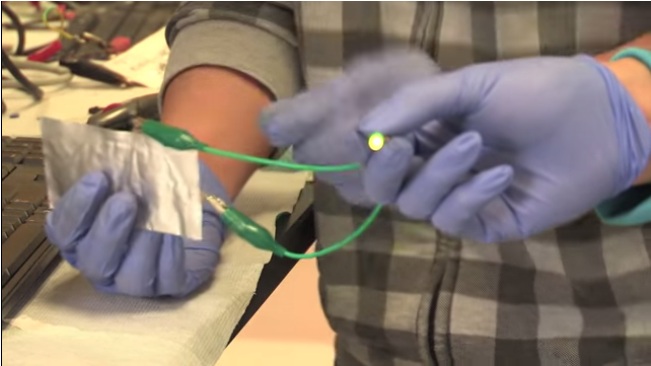Stanford Scientists Offer Promising New Aluminum Battery
 PALO ALTO, Calif., April 6 (UPI) — A newly developed aluminum battery could serve as a safer, high-performance alternative to today’s alkaline battery. The developers of the new energy storage device say it is the first aluminum-based battery capable of quickly storing and releasing energy.
PALO ALTO, Calif., April 6 (UPI) — A newly developed aluminum battery could serve as a safer, high-performance alternative to today’s alkaline battery. The developers of the new energy storage device say it is the first aluminum-based battery capable of quickly storing and releasing energy.
“We have developed a rechargeable aluminum battery that may replace existing storage devices, such as alkaline batteries, which are bad for the environment, and lithium-ion batteries, which occasionally burst into flames,” Hongjie Dai, a chemistry professor at Stanford University, said in a press release. “Our new battery won’t catch fire, even if you drill through it.”
Aluminum has long been targeted as an ideal element for energy storage. Its high-energy capacity, inflammability and low price make it ideal. The trouble for engineers has been finding the right material to pair with aluminum, a material capable of producing high voltage — especially after multiple cycles of rapid charging and discharging.
Researchers at Stanford happened upon graphite as the ideal accompaniment. The new aluminum-ion battery’s anode is made of aluminum and the cathode of graphite.
“People have tried different kinds of materials for the cathode,” Dai explained. “We accidentally discovered that a simple solution is to use graphite, which is basically carbon. In our study, we identified a few types of graphite material that give us very good performance.”
The two components are situated in a flexible polymer-coated pouch filled with an ionic liquid electrolyte.
In addition to being inflammable and fast-charging — scientists suggest the new battery could charge a smartphone in less than 60 seconds — it is also durable and flexible.
Whereas other aluminum batteries lose their storage capabilities after a few hundred charge-and-release cycles, Dai and his colleagues say their new battery can charge and release its energy some 7,500 times before it loses any capacity.
“Our battery produces about half the voltage of a typical lithium battery,” Dai said. “But improving the cathode material could eventually increase the voltage and energy density.”
“Otherwise, our battery has everything else you’d dream that a battery should have: inexpensive electrodes, good safety, high-speed charging, flexibility and long cycle life,” Dai added. “I see this as a new battery in its early days. It’s quite exciting.”
In addition to making small electronics more efficient and safe, the battery could also help electrical grids store large amounts of renewable energy.
The new battery is set to be detailed this week in the early online edition of the science journal Nature.
Copyright 2015 United Press International, Inc. (UPI). Any reproduction, republication, redistribution and/or modification of any UPI content is expressly prohibited without UPI’s prior written consent.
All rights reserved.





